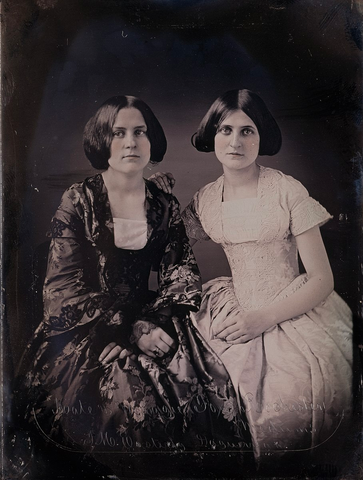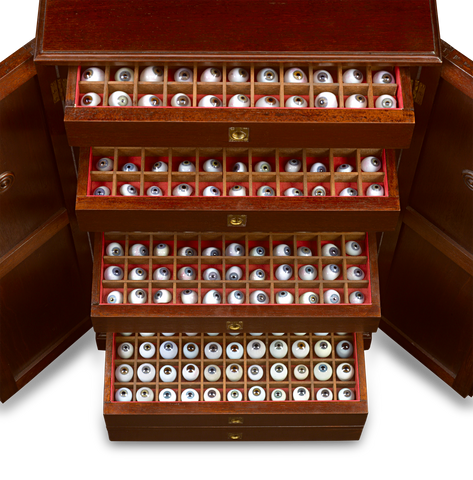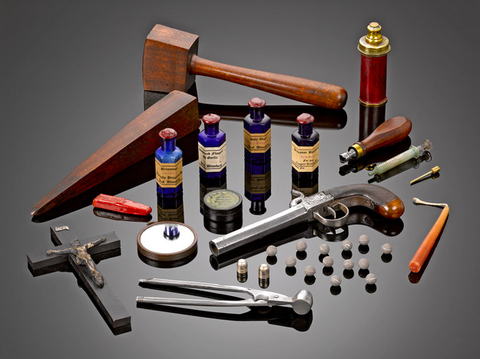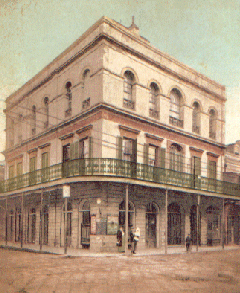In America, few locales possess an ambiance as enigmatic and mysterious as New Orleans. The city serves as a unique confluence for an array of haunting themes — most notably, haunted antiques, gothic and Victorian houses, and the settings of early horror literature. Join us as we unravel the intricate relationships between these compelling subjects, set against the backdrop of 19th-century art and architecture that is still as vibrant and spooky today as it was in its heyday.
St. Louis Cathedral, New Orleans, LA. 2009. Source.
The Evocative World of Haunted Antiques
Literary Beginnings: The Gothic and Haunted Objects
 Illustration for The Castle of Otranto, printed in Berlin, 1794, by Horace Walpole. Illustration by Johann Wilhelm Meil (1733-1805), engraved by Johann Friedrich Bolt (1769-1836). Harvard University.
Illustration for The Castle of Otranto, printed in Berlin, 1794, by Horace Walpole. Illustration by Johann Wilhelm Meil (1733-1805), engraved by Johann Friedrich Bolt (1769-1836). Harvard University.
First published in 1764, Horace Walpole's classic novella,
The Castle of Otranto, widely considered the first Gothic novel, set the standard for the genre with its blend of medievalism, romance and the supernatural. Early in the story, an impossibly large and mysterious helmet appears and quickly crushes Conrad, the young heir of the castle.
This event sets the narrative in motion, and leads Manfred, the lord of the castle, to question his own identity and authority as a ruler. The helmet is later revealed to be part of a suit of armor that belonged to Alfonso the Good, the former lord and rightful ruler of the estate, returning to correct the illegitimate rule of Manfred and restoring the estate to its rightful heir.
The object of the haunted helmet operates on multiple levels: its ghostly appearance serves to unnerve the characters and the readers alike, and it suggests themes of legitimacy and divine justice. Walpole's creation of this eerie artifact draws from the wellspring of classic literature to imbue an inanimate object with supernatural qualities.
This technique, now a crucial component of horror stories, replicated by the great writers Mary Shelley and Robert Louis Stevenson, Edgar Allan Poe and Henry James, to name a few, is both unsettling and familiar. Paradoxical haunted antiques—simultaneously lifeless and sentient—provide tangible objects through which audiences can delve into the enigmas of the mystical. These stories invited audiences to listen closely so they might hear the lingering narratives the departed may wish to convey from the realm beyond.
 Not Haunted - French Quarter Real Estate Office. 2015. Source.
Not Haunted - French Quarter Real Estate Office. 2015. Source.
Modern Fascination: New Orleans, the Haunted City Equal parts silly and haunting, The Castle of Otranto created a narrative archetype for an audience yearning to be transported to haunted realms of mystery, romance and escapism. Undoubtedly, society’s fascination with tales of the eerie and mystical persists.
A stroll through the streets of New Orleans in autumn reveals countless signs advertising ghostly city tours, explorations into Voodoo and visits to haunted houses. How do objects with rich histories contribute to this collective fascination? We invite you to join us in an exploration of the evolution from Gothic to Victorian horror, and the enduring magnetism of the macabre that continues to enthrall the modern imagination.
Victorian Horror and Its Lasting Cultural Impact
Spiritualism and Victorian Architecture
 Scrooge and the Ghost of Marley by Arthur Rackham, pen, ink and watercolor, from Dickens's A Christmas Carol, 1915. Source.
Scrooge and the Ghost of Marley by Arthur Rackham, pen, ink and watercolor, from Dickens's A Christmas Carol, 1915. Source.
Though Gothic literature relied on themes of haunting and the occult, it was in the Victorian Era when ghosts took centerstage in literature, on stage and in art. Some scholars this surge of ghostly popularity to the periodical press. When publishers needed a large amount of short and sweet content, ghost stories were an easy winner. American authors quickly realized that these tales were easy to write due to their generic and repetitive qualities, much like the modern superhero narrative.
These narratives were not limited to periodicals, however. Charles Dickens seized upon this popular genre with his 1843 serial narrative
A Christmas Carol. In this famed story, the notorious curmudgeon Ebenezer Scrooge is counseled by ghosts, both haunting and seemingly benevolent, and he ultimately becomes a more generous person.
Spiritualism in the Home: Shadows and Seances
 Portrait of Kate and Maggie Fox, Spirit Mediums from Rochester, New York. Missouri History Museum.
Portrait of Kate and Maggie Fox, Spirit Mediums from Rochester, New York. Missouri History Museum.
Some scholars attribute the Victorian Era’s love of ghost stories to specific economic and social upheavals that were taking over British society towards the end of the 19th century. The Industrial Revolution pushed many people to migrate from rural towns to cities, thus creating a new middle class who inhabited creaky and shadowy Victorian homes. With dim lanterns and the spread of spiritualism, many people began to hold seances in their homes, often attempting to communicate with those in the afterlife.
One of the best-known examples of this social phenomenon and effective schemes is that of young Victorian teenagers Maggie and Kate Fox who claimed to speak to spirits. While the girls were actually making cracking noises with their knuckles, toes and other joints, their captive audiences found both solace and horror in “communicating” through audible cues with spirits.
The girls eventually went on tour, “performing” their spiritualist seances in front of crowds of 400+ people. Although the girls certainly had critics, there were also plenty of believers, including Sir Arthur Conan Doyle, who adamantly believed in their abilities.
 Picture of Mary Lincoln with the ghost of her husband Abraham Lincoln behind her. Circa 1872. Source.
Picture of Mary Lincoln with the ghost of her husband Abraham Lincoln behind her. Circa 1872. Source.
Additionally, the growth of photography brought about spirit photography— a market wherein photographers would claim to photograph people with the spirits of their lost loved ones. What most people did not know is that this feat was relatively easy with double exposure photography techniques. One of the most popular examples of this is Mary Todd Lincoln’s portrait with her late husband’s hands resting on her shoulders.
New Orleans: The Epicenter of Mystery
Though spiritualism and Victorian aesthetics spread around the nation, perhaps few modern cities still evoke the auspicious lore of this bygone age than New Orleans. Boasting a 300+ year history, almost ancient history by American standards, the city features almost countless haunting tales of military skirmishes, natural disasters and eerie patrons.
Tales of the supernatural are deeply embedded in the architecture and streets of New Orleans. The French Quarter serves as an epicenter for such spectral accounts, with nearly every building harboring its own unsettling narrative. Walk with us down Royal Street as we peek into some of these hallowed spaces.
LaLaurie Mansion:
LaLaurie Mansion. 1906 Postcard. Source.
The LaLaurie Mansion in New Orleans has long been the subject of both historical inquiry and lore, gaining fame for its grisly past. Owned by Madam Delphine LaLaurie in the early 19th century, the mansion sitting at Royal and Governor Nicholls street is infamous for the appalling treatment of enslaved individuals at her hands.
Though her mistreatment of enslaved peoples was a well-known “secret” in New Orleans society, an 1834 fire publicly revealed the extent of the horrors, exposing inhumane conditions and triggering public outrage. Following the revelation that seven enslaved peoples were locked in the home to burn alive, Delphine LaLaurie fled the city, likely for Paris. Over the years, the mansion has changed hands multiple times and is often cited in tales of hauntings and paranormal activity.
Haunted Medical AntiquesThe Pharmacy Museum, one of M.S. Rau’s closest neighbors, is the former apothecary of America's first licensed pharmacist, Louis J. Dulilho, Jr. This popular destination stands as a complex testament to the history of medicine.
In 1855, the property transitioned to the ownership of Dr. Joseph Dupas, a physician of questionable repute. Known for numerous health code infractions and dangerous medical practices, Dupas egregiously violated ethical boundaries by conducting inhumane experiments on enslaved pregnant women.
Presently, the museum serves as a venue for exhibitions that delve into the often unsettling elements of 19th-century medical history, ranging from bloodletting to Voodoo elixirs. Anecdotal accounts suggest that after hours, the specter of Dr. Dupas lingers, with modern tales of moving objects and mysteriously triggered security systems.
 French Ocularist's Glass Eye Cabinet. 19th Century. M.S. Rau.
French Ocularist's Glass Eye Cabinet. 19th Century. M.S. Rau.
Think You’ve Seen it All? Though we don’t often acquire medical antiques here at M.S. Rau, we have had a few eerie items trickle in. This collection of hand-blown glass eyes, for example, would have been an essential part of a 19th-century ocularist’s office. With over 600 eyes, the haunting effect of this collection is something you’d have to see to believe.
 Vampire Killing Kit. 19th Century. M.S. Rau.
Vampire Killing Kit. 19th Century. M.S. Rau.
Protect Your Neck! Not all medical devices were used to treat ailments one could see, however. This rare and complete vampire-killing kit, attributed to the eminent and enigmatic Professor Ernst Blomberg, is a must-have for all would-be vampire slayers.
It contains all of the essential implements for the destruction of and defense against the undead. Such kits were commonly available to travelers in Eastern Europe in the 18th and 19th centuries, and many were also made in the early 20th century in response to the interest in vampires sparked by the publication of Bram Stoker's Dracula.
Interested in more
Medical Antiques and
Gothic Antiques? Check out our collections at M.S. Rau!
























